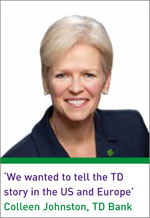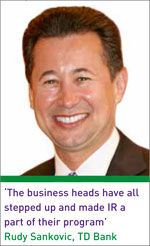Customer service equals 'platinum' IR at the peerless Canadian bank
Soon after Colleen Johnston became chief financial officer of TD Bank in 2005 she made a decision in concert with chief executive Edmund Clark to make investor relations of strategic importance to the Canadian bank.
Last year, TD Bank collected five trophies at the IR Magazine Canada Awards, including the gongs for best IR by a CEO and best IR by a CFO for Clark and Johnston, respectively.
This year, the bank added the best corporate governance award to the five awards it retained from 2011, and took the top spot in the Canada Top 50, the rankings of the best IR programs in Canada as compiled by IR Insight, the research arm of IR magazine.
You were short-listed in nine categories at this year’s IR Magazine Canada Awards. Why do you think your investor relations program is so strong across the board? Colleen Johnston: We were fortunate last year to win five awards. When I accepted one [on stage] I mentioned that we had decided six years previously that we wanted to make investor relations a competitive advantage for TD.
Colleen Johnston: We were fortunate last year to win five awards. When I accepted one [on stage] I mentioned that we had decided six years previously that we wanted to make investor relations a competitive advantage for TD.
That was in the context of a growing organization and we have certainly grown significantly in the last six years.
As a Canadian bank, we have a terrific reputation as a well-run company and we have tremendous shareholder support on both the retail and institutional sides.
But the reality is that the Canadian market is a small market. What we needed to do was start thinking about penetrating other markets beyond our core: we wanted to tell the TD story in the US and Europe.
More recently we’ve also had a global IR strategy focused on sovereign wealth funds and ultra- high-net-worth investors in the Middle East and the Far East. That program is in its early stages. Rudy Sankovic: As Colleen mentioned, IR has become a strategic emphasis for us. We have a philosophy that’s built on platinum service. When I joined the team [in 2011], I could really see it in full force.
Rudy Sankovic: As Colleen mentioned, IR has become a strategic emphasis for us. We have a philosophy that’s built on platinum service. When I joined the team [in 2011], I could really see it in full force.
We just do things a bit better than everyone else; we don’t do it differently.We have a mantra around transparency, responsiveness and value-add – those are the three things that drive everything we do. When you look at our investor relations team structure and program today, you can see that it isn’t just words on paper, either. That is really how it works.
There are 10 people in the IR team and there are three executives among those 10, including myself, so we have brought to the table senior power and people who understand the business, have financial acumen, can understand investor and analyst views and can respond fast to that. We have a structure that says we are serious about IR.
What’s really important is that it’s not only Colleen and Ed who have been key for our investors, but also the business heads have all stepped up and made IR a part of their program.
It’s almost like it’s part of their job mandate that they are as much linked with investors as Colleen and the investor relations team, so we have key executives who put in a lot of time with us.
Whether it’s conferences, one-on-ones or roadshows, they are there as much as Colleen and Ed would be, and that’s a huge differentiator. We are there with the entire executive team, not just a couple of folks representing us.
The proactive outreach is another differentiator. We are actually out there talking to people. We phone them after quarter-end results, for example, to see how they feel about our performance. In fact, I think we are the only folks who do that.
On the morning our earnings results are released, Colleen will be on the phone to each of our 17 analysts talking to them and listening to their concerns and questions. That’s an example of an IR strategy that looks a lot different from the rest of the Street.
How does that compare with the investor relations set-up six years ago?
CJ: Six years ago we had a very capable team; we were a traditional investor relations group. IR is a pretty new discipline in many organizations.
Often you would have somebody in the financial department who did investor-related stuff but the notion of professional IR is a newer discipline.
So TD Bank wasn’t unusual in that we had a traditional investor relations group with a handful of capable IR people. I don’t want to take away from what they did in those days; we just said we wanted to make it a strategic advantage.
For example, at the time, a vice president in the bank ran the IR group. We decided that this was more of a senior vice president role. In Rudy’s case, he’s a seasoned senior vice president.
He was a CFO in one of our major businesses prior to coming into this role. Also, we probably have the largest IR group of any of the major banks in Canada. The group did a good job but we decided to be more proactive and expand the program. That’s been helpful.
RS: We have a small team that caters to the sell side and another small team that caters to our investment community. Our structure is quite different from other Canadian banks in that we have two avenues: one that knows analysts and how they think, and another that understands how the investment community thinks. That way you build a real knowledge base in both.
Kelly Milroy [associate vice president of investorrelations], for instance, runs the analytics group. He has been in the chair for eight years and really knows how to service analysts with quick, high-quality responses and good insights. That team really steps up and gets accolades from analysts.
Similarly, on the investor side, we have a team that focuses exclusively on our investment community, particularly the top 50-100 shareholders. That team drills down into the organizations and tries to understand what they need from us.
CJ: Another change we introduced in the last six years is a disciplined quarterly process of ensuring we have a full analysis of all our external disclosures and all the explanations around variances or anything unusual that might be of interest to an investor or analyst.
That has helped arm all the folks involved in talking to investors and analysts so that they are able to answer questions in a consistent way with speedy, high-quality responses.
Because not every analyst and investor phones me all the time – they phone IR – what I wanted to make sure of was that anyone communicating with investors or analysts had that same in-depth knowledge and consistency of knowledge and immediate information. That lets us provide even quicker turnaround.
Six years ago the IR group would get a question, then go find the answer and come back and answer the analyst or investor. They were intermediaries; they didn’t necessarily have the deep knowledge but they were certainly able to go and get it.
It’s important to be able to tell the story in the context of the big picture, but it’s also important for us to know those numbers in detail.
TD Bank IR: 2011 in numbers17 analysts77% institutional shareholders, up from 69% four years ago 68% Canada-based investors, 32% US and international Attended nine conferences Met with 87 potential new investors Conducted 250 investor meetings spanning 17 cities andthree continents Held 400 face-to-face interactions through one-on-ones, group meetings, conferences, roadshows, bank tours and social events |
This is an extract from a profile of TD Bank that appears in the Investor Perception Study, Canada 2012. To order a copy of the report, please contact Brigitte toledano at brigitte. toledano@thecrossbordergroup.com










